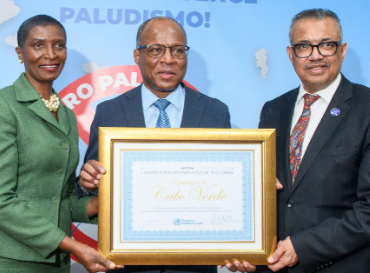Context
The World Health Organization (WHO) has officially certified Cape Verde, as malaria-free, making it the third country in the African region to achieve this status.
About
- Cabo Verde has attained the prestigious status of being malaria-free, joining the ranks of Mauritius and Algeria, who achieved this certification in 1973 and 2019, respectively.
- Despite having the highest malaria burden, with Africa accounting for around 95% of global malaria cases and 96% of related deaths in 2021.
- The World Health Organization (WHO) has now recognized 43 countries and 1 territory as malaria-free, reflecting collective progress in combating the disease on a global scale.
WHO
- Founded in 1948.
- It is the United Nations agency that connects nations, partners and people to promote health, keep the world safe and serve the vulnerable – so everyone, everywhere can attain the highest level of health.
- It leads global efforts to expand universal health coverage.
Malaria
- According to WHO, Malaria is an acute febrile illness caused by Plasmodium parasites, which are spread to people through the bites of infected female Anopheles mosquitoes. It is preventable and curable.
- Types of parasites – There are 5 parasite species that cause malaria in humans: P. malariae, P. ovale and P. knowlesi. Plasmodium vivax, and P. falciparum.
- Two of these species – Plasmodium falciparum and Plasmodium vivax – pose the greatest threat.

Symptoms:
- First symptoms typically appear 10–15 days post-mosquito bite.
- Common initial symptoms include fever, headache, and chills.
- Initial symptoms may be mild and challenging to identify as malaria.
- Some individuals in endemic areas may be asymptomatic due to partial immunity.
- Severe malaria manifests as multi-organ failure in adults and severe anaemia, respiratory distress, or cerebral malaria in children.
Global Malaria Distribution:
- Malaria is predominantly present in tropical and subtropical countries.
- WHO African Region bears the majority of malaria cases and deaths. Plasmodium falciparum is the predominant parasite in this region. Other malaria hotspots include South-East Asia, Eastern Mediterranean, and Western Pacific, where Plasmodium falciparum is also prevalent.
- In the WHO Region of the Americas, Plasmodium vivax is the dominant parasite.
- Sub-Saharan Africa faces the highest threat of malaria. Four countries in this region accounted for nearly half of global malaria deaths in 2022: Nigeria (31.1%), Democratic Republic of the Congo (11.6%), Niger (5.6%) and United Republic of Tanzania (4.4%).
- In India: Malaria remains a serious public health problem in India with about 20,000 deaths annually. In southeast Asia, India accounts for 79% of the region’s malaria burden and 82.4% of all malaria deaths in 2021. -Sources: WHO
Reasons for Malaria Prevalence in India:
Geographic and Ecological Diversity:
- Diverse landscapes with varying climates, topography, and mosquito species.
- Regions like the north-east, east, and central areas with hilly and forested terrain are prone to higher transmission due to conducive breeding grounds for mosquitoes.
Prevalence of Plasmodium vivax:
- India shoulders 47% of the global burden of Plasmodium vivax.
- The parasite’s complex life cycle, involving relapses, poses challenges to eradication efforts.
Socioeconomic Determinants:
- High burden areas characterized by poverty, limited healthcare access, and inadequate sanitation.
- Conflict-affected regions face additional challenges due to resource constraints and infrastructure limitations.
- Limited awareness, especially among marginalized communities, hampers malaria prevention efforts.
Seasonal Variation:
- Monsoon season facilitates mosquito breeding with heavy rainfall.
Vector Control Challenges:
- Insufficient coverage of mosquito nets, insecticides, and larvicides in vulnerable areas.
Population Movement:
- Mobile and migrant populations from high-endemic regions may introduce malaria into low-transmission areas.
Historical Resurgence and Fragile Progress:
- Past outbreaks (e.g., 1976) underscore the need for sustained efforts.
Inadequate Infrastructure and Monitoring:
- Gaps in healthcare facilities, surveillance systems, and logistics impede effective control measures.
India’s Initiatives:
- National Framework for Malaria Elimination 2016-2030: Aims to eliminate malaria in India by 2030, aligning with WHO’s strategy.
- National Vector-Borne Disease Control Programme: Addresses vector-borne diseases, including malaria, through prevention and control measures.
- National Malaria Control Programme (NMCP): Launched in 1953, focuses on insecticidal spray, monitoring, surveillance, and patient treatment.
- High Burden to High Impact (HBHI) Initiative: In four states (West Bengal, Jharkhand, Chhattisgarh, and Madhya Pradesh), targets malaria reduction through insecticidal net distribution.
- Malaria Elimination Research Alliance-India (MERA-India): Established by ICMR, collaborates on malaria control research.
Global Initiatives:
- WHO’s Global Malaria Program: Coordinates global efforts, guided by the “Global technical strategy for malaria 2016–2030,” aiming for a 90% reduction in incidence and mortality by 2030.
- Malaria Elimination Initiative: Led by the Bill and Melinda Gates Foundation, focuses on eradicating malaria through diverse strategies.
- E-2025 Initiative: Launched by WHO in 2021, aims to stop malaria transmission in 25 countries by 2025.
Way Forward
- Prioritize equitable healthcare access, emphasizing prevention through mosquito nets and environmental measures.
- Invest in research for new tools and vaccines, empower communities through awareness, and promote global collaboration for accelerated progress toward a malaria-free world.

